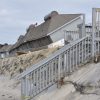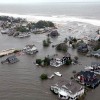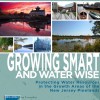Regional Planning
Recognizing the need for better land-use decisions, and the limitations of effective municipal governance, the New Jersey Legislature has passed an impressive succession of laws to promote regional planning.
Through these efforts, the Legislature showed its willingness to retrieve powers it had earlier delegated to the municipalities under the Municipal Land Use Law and other statutes in order to transform land-use governance in specific locations. The most significant statutes in this series are the Hackensack Meadowlands Development Act (1969), the Pinelands Protection Act (1979) and the Highlands Water Protection and Planning Act (2004). Together these regional areas comprise 2,800 square miles, or 37 percent of the state’s land area. Regional planning occurs in a less comprehensive manner on the county level, authorized by the New Jersey County Planning Enabling Act (1935). Other groups of municipalities have formed voluntary regional planning organizations in areas including the Sourland Mountain Area and the Great Swamp Watershed.
In 2012, after Hurricane Sandy devastated the New Jersey Shore, that area became a new focus for conversations around regional planning. To help inform the discussion, New Jersey Future has built a resource page focused on rebuilding a resilient shore.

While New Jersey is one of the most diverse states in the nation at the macro level, at the local level it is also one of the most segregated. The state has grown more demographically diverse over the last two decades, but most of its individual towns and neighborhoods are either predominantly white or predominantly non-white, with few places occupying the “diverse” range in between.

Both before and after Superstorm Sandy, the trend at the Jersey Shore has been toward higher home values, a smaller percentage of housing units being occupied year-round, and an increasing presence of retirees among year-round residents. Is the Shore becoming a playground for the rich? And specifically rich retirees?

New Jersey’s system for delivering public education is particularly fragmented—it averages 28 school districts per county, the most of any state, and averages just under 15,000 residents per district, well below the national average of 23,344. It has more school districts than it has municipalities. This fractionalized landscape contributes to and exacerbates several of the state’s most intractable problems in ways that are not immediately apparent.

The science is clear: climate change is here, and its threats are only going to grow more pronounced. But, carefully coordinated efforts can not only protect New Jerseyans from these threats, but can help spur economic activity, as well, making our state that much stronger. That was the message from four senior-level officials from Governor Murphy’s administration at the 2021 Planning and Redevelopment Conference, hosted by New Jersey Future and the NJ Chapter of the American Planning Association.

New Jersey should follow Oregon’s and California’s lead and take advantage of the growing national momentum toward zoning reform, to at least begin a discussion about how such reforms might work in New Jersey.

A one-hour webinar explaining a new, parcel-based tool that assesses financial vulnerability to coastal flooding and sea-level rise. Friday, May 15, 2015, noon – 1:00 pm.
An interim report, three years after Hurricane Sandy, on New Jersey Future’s groundbreaking local recovery planning manager program, including lessons learned and recommendations. October 2015.
Oct. 28, 2014 — Two years after the devastation wrought by Hurricane Sandy, many of New Jersey’s coastal communities continue to struggle with recovery and rebuilding efforts. The highest community priority is to get people back into their homes, re-establish business operations and return to life as close to normal as possible. The elected officials who have led these efforts are hardworking heroes. But it’s also clear that recovery decisions made without a clear understanding of future risks can move people back into harm’s way, build infrastructure that will be damaged again, and waste taxpayer dollars.

Development in the Pinelands growth areas has affected water resources and will continue to exert pressures going forward. This report highlights what can be done by municipal, regional and state agencies to minimize their negative impacts. July 2014.

This report and related case studies summarize the state of urban water infrastructure in New Jersey and how it affects residents and businesses. May 2014.
See all New Jersey Future Blog posts and articles in this category »
Reports, Presentations and Testimony
- New Jersey Future Resilient Coastal Communities Phase 2 Report 5-22-18
- New Jersey Future Resilient Coastal Communities Phase 2 Report appendices 5-22-18
- 01/30/2019: Testimony on CAFRA Center Extension
- 05/10/2018: New Jersey Future Testimony on S1333
- Mystic Island HIA Report 6-7-16
- New Jersey Future Resilient Coastal Communities Project Report Appendix 6
- New Jersey Future Resilient Coastal Communities Project Report Appendix 4
- New Jersey Future Resilient Coastal Communities Project Report Appendix 3 Figures
- New Jersey Future Resilient Coastal Communities Project Report 2017
- 09/15/2017: Comments on Proposed Changes to Coastal Zone Management Rules
- 08/10/17: Broccoli joint committee climate change hearing testimony
- 08/10/2017: Testimony for NJ Joint Environment Committee
- New Jersey Future 2017 Gubernatorial Platform
- Little Egg Harbor Township Vulnerability Assessment Report 02-2015
- Strategic Recovery Planning Report Maurice River 05-2015
- Strategic Recovery Planning Report Commercial 12-2015
- 2013 Facing Our Future Report - Infrastructure Investments Necessary for Economic Success - Links to Water Infrastructure Resources
- NJFuture-In-Deep-10-15-WEB
- Sample Local Recovery Planning Manager Resolution of Engagement
- Sample Local Recovery Planning Manager Memorandum of Agreement
- Risk analysis public mtg presentation Tuckerton-Little Egg Harbor 4-14-15
- Strategic Recovery Planning Report Tuckerton 4-15-15
- Local Recovery Planning Manager Scope of Services Tuckerton-Little Egg Harbor 1-31-14
- Sea Bright exposure analysis
- New Jersey Future Stormwater Utilities Report 9-14 (Intern Report)
- PINELANDS_WEB_8_4_14-1
- New Jersey Future Van Abs 2014 Pinelands Growth Area Water Assessment
- Agenda for Change
- 03/05/2014: Sandy Action Plan Amendment Planning Letter
- 03/05/2014: Sandy Action Plan Amendment Resiliency Letter
- 02/12/2014: Testimony on Proposed Sandy Plan Still Puts Taxpayer Dollars at Risk
- Sandy Recovery Action Plan Selected Comments
- Somerset County Investment Framework 1-13 (Intern Report)
- NJ Shore Protection Master Plan 1981 vol 3 Comments
- NJ Shore Protection Master Plan 1981 vol 2 Basis and Background
- NJ Shore Protection Master Plan 1981 vol 1 Part II
- NJ Shore Protection Master Plan 1981 vol 1 Part I
- Targeting Transit -- New Jersey Future
- Wastewater Planning County Fact Sheets
- County Planning in New Jersey 4-12 (Intern report)
- Cluster Presentation - NJ Farm Bureau 1-4-2012
- DKennedy State Strategic Plan APA-NJ 11-4-2011
- BBzik State Strategic Plan Somerset County Perspective 11-4-2011
- Smart Growth NJ August 2011 Poll Report
- Route 1 Planning Through Partnerships
- ShapingNJ Community Pilot Meeting Overview 06-09-11
- Case Studies in Transfer of Development Rights 8-10 (Intern report)
- ARC Information Sheet 9-10
- Transfer of Development Rights Task Force Report 08-11-10
- Case Study Hopewell Township 08-00
- Presentation: The Status of Transfer of Development Rights in New Jersey 12-10
- Presentation: Reining In Local Budgets 05-10
- Smart Conservation: The "Green" Side of Smart Growth
- Race to the Middle: The Homogenization of New Jersey's Population Density
- Realistic Opportunity? The Distribution of Affordable Housing and Jobs in New Jersey
- Getting to Work 11-08











